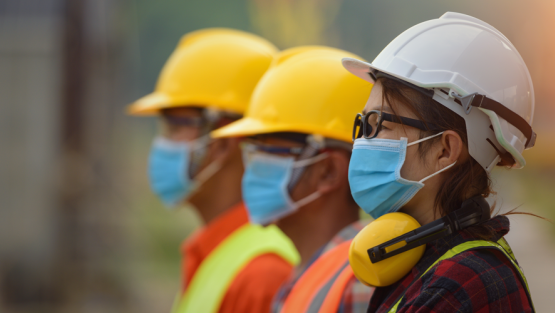Blockage orders, labor shortages, supply chain disruptions, funding burdens, global construction sector hits 3.1% reduction in 2020, The worst decline since the 2008 global financial crisis. Even if the construction industry was allowed to continue its activities, public agencies around the world closed the doors and stopped granting construction permits or providing site supervision for
Blockage orders, labor shortages, supply chain disruptions, funding burdens, global construction sector hits 3.1% reduction in 2020, The worst decline since the 2008 global financial crisis. Even if the construction industry was allowed to continue its activities, public agencies around the world closed the doors and stopped granting construction permits or providing site supervision for ongoing construction projects for several months at a time. , Many projects have been postponed or completely frozen. In other countries, permit approvals were still issued and construction work was considered an “essential project”. Many companies still chose to shut down because it was considered unrealistic or unsafe to resume construction safely. However, in some countries, construction activities have been found to continue uninterrupted, even during the period of a forced stay-at-home order, where many other business activities were suspended.Recently Case Study Shows how digital solutions allow construction work to continue in these locations, despite unprecedented challenges such as those due to social distance protocols.
To accommodate the COVID-19 pandemic, the construction industry has adopted digital tools that facilitate virtual interactions such as digital architectural plan reviews and video remote inspections. | World Bank Photobook.
Early in the pandemic, the government sought to limit the turmoil by mandating social distance and hygiene protocols to ensure the well-being and health of construction workers. For example, in the United States, the Housing and Architecture Bureau of Los Angeles has adopted a set of safety construction guidelines based on the recommendations of the Centers for Disease Control and Prevention. It consists of 16 rules such as social distance, frequent hand washing, and wearing a face mask while working. on site. Inspections were also required to ensure compliance with on-site guidelines. Similarly, in China, 58 million workers are employed in the construction sector, The National Health Commission has introduced detailed guidelines on the management of construction sites. It included shift work, use of protective equipment, disinfection of areas without proper ventilation, occupational health and safety training, and regular health examinations.
However, the most important changes to construction focused on remote work and digital tools to promote the continuity of construction projects beyond hygiene and safety. Fully digitized processes have proven to be important to enable business continuity and processing at extraordinary times for services. Since 2007, 29 economies have set up web-based portals to coordinate the building permit process. First introduced in 2001, Singapore’s Construction Real Estate Network (CORENET) electronic submission platform already has all the elements for a fully digitized construction plan submission, checking and approval process, and the country has Allowed to continue all licensed services remotely, even during the “circuit breaker” period of strict social distance from April to May 2020. The process is completely paperless, as electronic formats and signatures already make physical document submissions and direct meetings redundant. In other countries, not all information technology infrastructure was in place, but we responded quickly to the pandemic by deploying or enhancing e-government platforms and solutions that enable continuity in the construction sector.Morocco Rokhas platformFor example, improvements have been made to allow video conferencing and architectural plan reviews digitally and remotely. During 2020 Yangon, Myanmar has expanded the use of digital construction permits, It has been piloted for 2 years and the Benin government has also Digital application portal..
Building permit authorities around the world also faced the challenge of ensuring building quality control for construction projects in the event of a health emergency. Authorities around the world are using inexpensive, readily available digital tools to perform inspections remotely, rather than continuing their business as usual or suspending inspections altogether. Kuwait was one of the first companies to replace direct inspection with photo and video submissions to ensure that qualified engineers performed quality control.In the United States Miami city Virtual inspections of construction sites via Zoom or Microsoft Teams video calls are now routine between site engineers and building managers. United Arab Emirates authorities will already use CCTV and drones to inspect construction sites prior to the COVID emergency and rebuild capabilities to move further to virtual and remote inspection from March 2020. Is done.
Having an electronic submission system does not guarantee the continuation of service provision. The construction permit process is often complex and often involves multiple agencies that must review and approve the application and collect the appropriate fees before the permit is issued. However, some prerequisites need to be set to ensure that the paper-to-digital permit and inspection transition is carried out. Investing in software and cybersecurity is required to meet records management and privacy requirements. Existing software must be adapted to support video conferencing and real-time interactions. Criteria for using 3D or 4D format must be agreed with the private sector. Electronic payments need to be integrated into the platform. Multiple agencies involved in the building permit process must also be granted access and included in the digital platform. And above all, both the private sector and civil servants need to be trained and confident about the benefits of using these digital tools. Even in developed countries, this can be a daunting task. In the United States 40% of local building permit department Report inability to carry out electronic planning reviews, 60% reported not ready for remote virtual inspection.. Launching electronic platforms or imposing virtual remote inspections on local governments and the private sector that are not prepared for the digital leap could further increase the unprocessed portion of building permits and delay the recovery of the construction industry.Recently Case Study More and more governments are showing that they are already taking serious steps to accelerate the digitization of construction that permits and promotes the use of joint software prior to the COVID pandemic. As countries prioritize the kickstart economy and the revival of the construction industry, it is even more urgent to move to more efficient and digital processes.



























Leave a Comment
Your email address will not be published. Required fields are marked with *